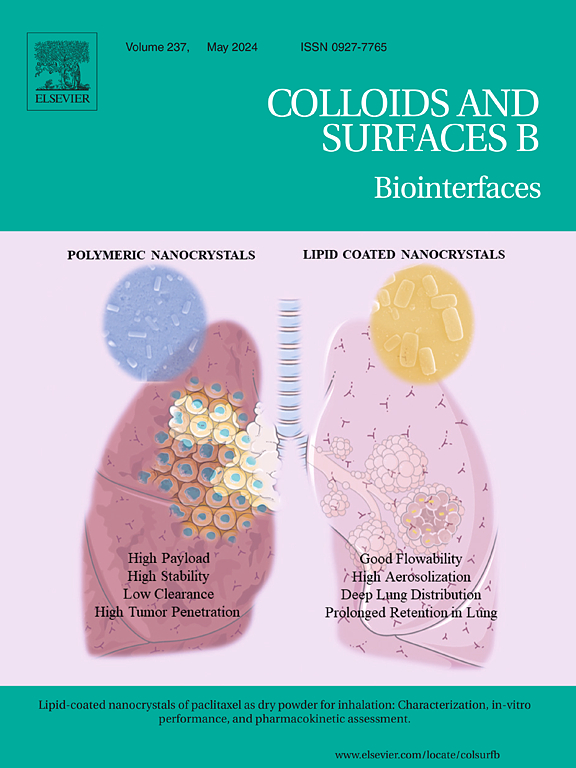nir触发的原位自供H2O2通过cuo2介导的催化级联反应促进光热消毒
IF 5.4
2区 医学
Q1 BIOPHYSICS
引用次数: 0
摘要
在此,我们构建了一个近红外(NIR)响应的cu /CuO2级联纳米酶系统,解决了传统治疗中外源H2O2依赖性的关键限制。该系统采用基于级联纳米酶的nir响应抗菌cu /CuO2复合材料。负载CuO2纳米粒子(NPs)在近红外(808 nm)照射下自发生成Cu2+和H2O2。这启动了双重催化途径:(1)Cu2+介导的fenton样反应和(2)h2o2激活的过氧化物酶样活性,协同产生·OH自由基(epr证实)。在近红外照射下,CuO2释放H2O2,激活cu的过氧化物酶样活性。在接下来的级联反应中,Cu2+催化了类似fenton的反应,产生了大量的·OH,而H2O2则激活了cu /CuO2复合物中类似过氧化物酶的活性。此外,cu /CuO2还表现出类似氧化酶的活性。氧化酶样活性加上光热条件下模拟的级联反应,使CuS/CuO2(100 μg/mL)能有效杀灭大肠杆菌(E. coli)、金黄色葡萄球菌(S. aureus)和耐甲氧西林金黄色葡萄球菌(MRSA)。此外,cu /CuO2复合物能有效抑制大肠杆菌、金黄色葡萄球菌和MRSA生物膜的形成。·OH被证实是cu /CuO2抗菌过程中的主要自由基。体内抗感染实验证明,在近红外照射下,cu /CuO2可以加速伤口愈合,毒性可以忽略不计。这种自我维持的系统消除了外源H2O2的需求,同时通过光热增强的纳米酶级联实现组合抗菌效果。本文章由计算机程序翻译,如有差异,请以英文原文为准。
NIR-triggered in situ self-supplied H2O2 for boosting photothermal disinfection via CuO2-mediated catalytic cascade reaction
Herein, we constructed a near-infrared (NIR) responsive CuS/CuO2 cascade nanozyme system addressing the critical limitation of exogenous H2O2 dependency in conventional therapies. This system incorporates NIR-responsive antibacterial CuS/CuO2 composite based on cascade nanoenzymes. The loaded CuO2 nanoparticles (NPs) spontaneously generate Cu2+ and H2O2 in situ upon NIR irradiation (808 nm). This initiates a dual catalytic pathway: (1) Cu2+-mediated Fenton-like reactions and (2) H2O2-activated peroxidase-like activity, synergistically producing ·OH radicals (EPR-confirmed). Under NIR irradiation, CuO2 releases H2O2 that activates the peroxidase-like activity of CuS. During the following cascade reaction, Cu2+ catalyzes a Fenton-like reaction to produce a large amount of ·OH, while H2O2 activates peroxidase-like activity in the CuS/CuO2 composite. Additionally, CuS/CuO2 also exhibits oxidase-like activity. The oxidase-like activity coupled with the cascade reaction simulated with photothermal conditions allows CuS/CuO2 (100 μg/mL) to effectively destroy Escherichia coli (E. coli), Staphylococcus aureus (S. aureus), and Methicillin-resistant Staphylococcus aureus (MRSA). Moreover, the CuS/CuO2 composite effectively inhibits the formation of biofilms of E. coli, S. aureus, and MRSA. ·OH was confirmed to be the main free radical during the antimicrobial process of CuS/CuO2. In vivo anti-infection assays prove that CuS/CuO2 could accelerate wound healing under NIR irradiation with negligible toxicity. This self-sustaining system eliminates exogenous H2O2 requirements while achieving combinatorial antimicrobial efficacy through photothermal-potentiated nanozyme cascades.
求助全文
通过发布文献求助,成功后即可免费获取论文全文。
去求助
来源期刊

Colloids and Surfaces B: Biointerfaces
生物-材料科学:生物材料
CiteScore
11.10
自引率
3.40%
发文量
730
审稿时长
42 days
期刊介绍:
Colloids and Surfaces B: Biointerfaces is an international journal devoted to fundamental and applied research on colloid and interfacial phenomena in relation to systems of biological origin, having particular relevance to the medical, pharmaceutical, biotechnological, food and cosmetic fields.
Submissions that: (1) deal solely with biological phenomena and do not describe the physico-chemical or colloid-chemical background and/or mechanism of the phenomena, and (2) deal solely with colloid/interfacial phenomena and do not have appropriate biological content or relevance, are outside the scope of the journal and will not be considered for publication.
The journal publishes regular research papers, reviews, short communications and invited perspective articles, called BioInterface Perspectives. The BioInterface Perspective provide researchers the opportunity to review their own work, as well as provide insight into the work of others that inspired and influenced the author. Regular articles should have a maximum total length of 6,000 words. In addition, a (combined) maximum of 8 normal-sized figures and/or tables is allowed (so for instance 3 tables and 5 figures). For multiple-panel figures each set of two panels equates to one figure. Short communications should not exceed half of the above. It is required to give on the article cover page a short statistical summary of the article listing the total number of words and tables/figures.
 求助内容:
求助内容: 应助结果提醒方式:
应助结果提醒方式:


